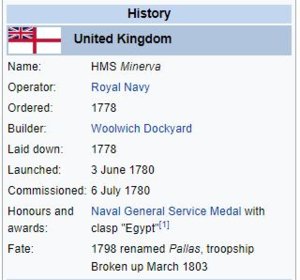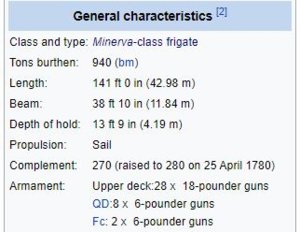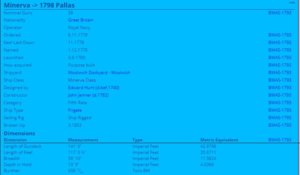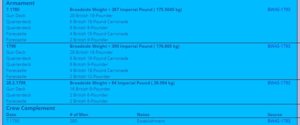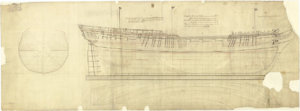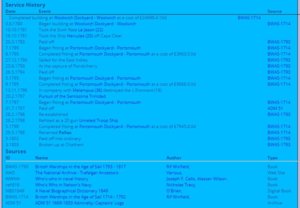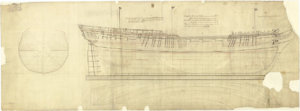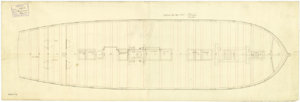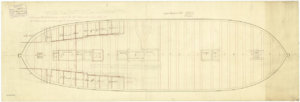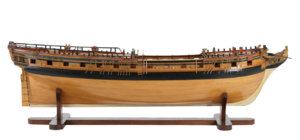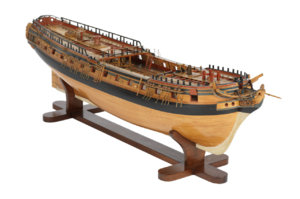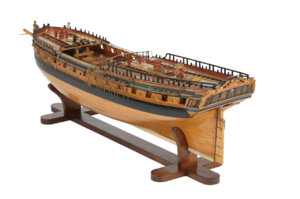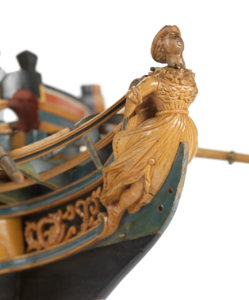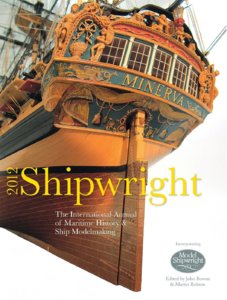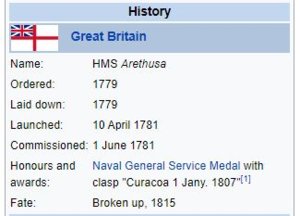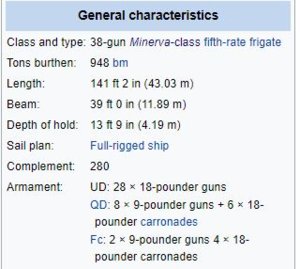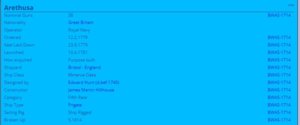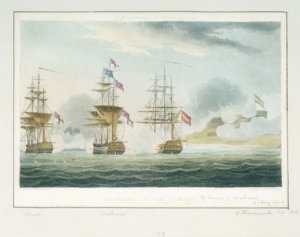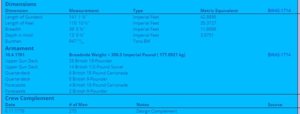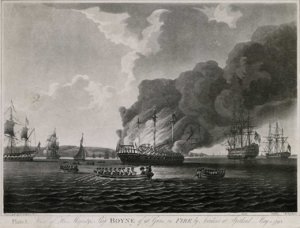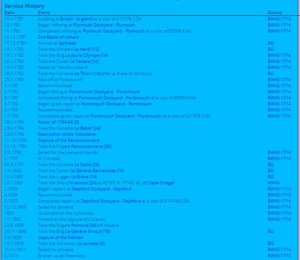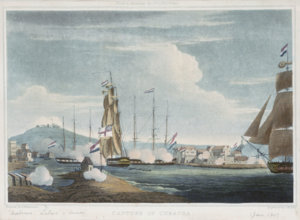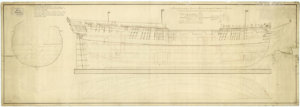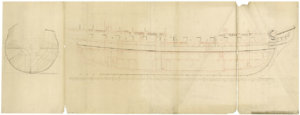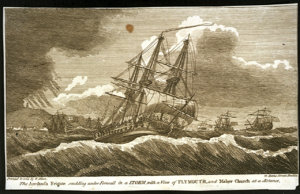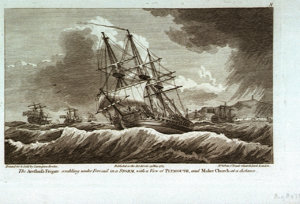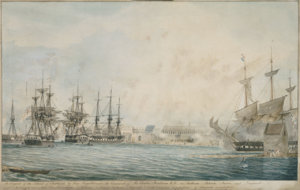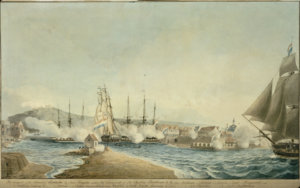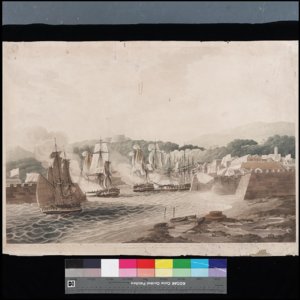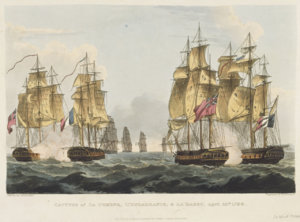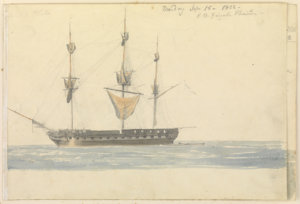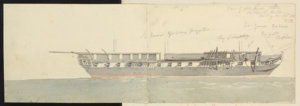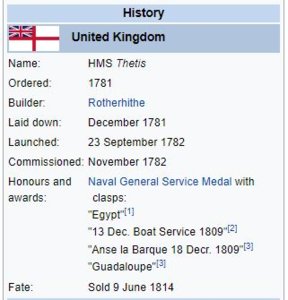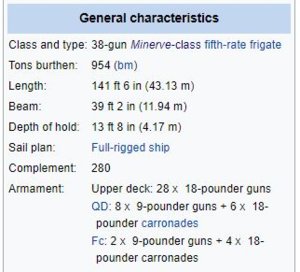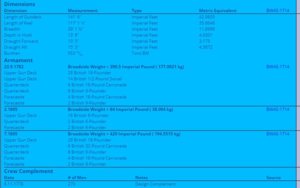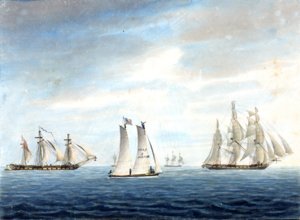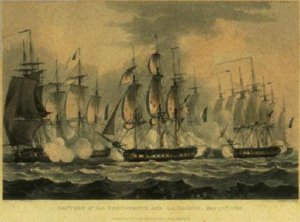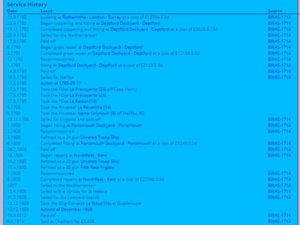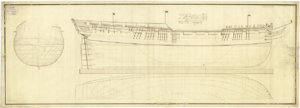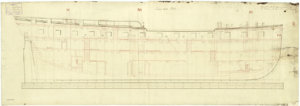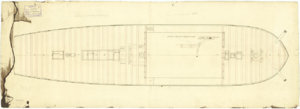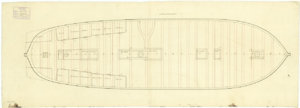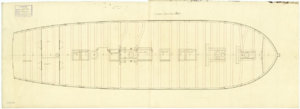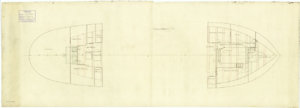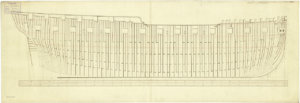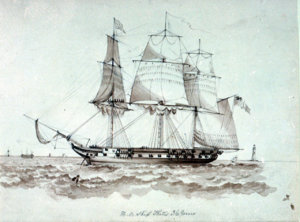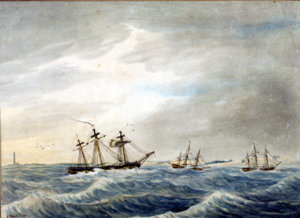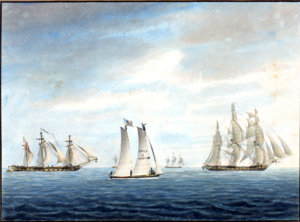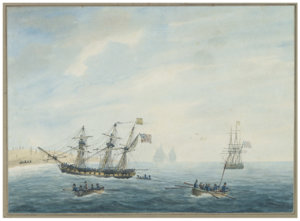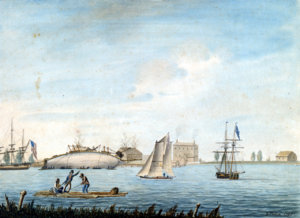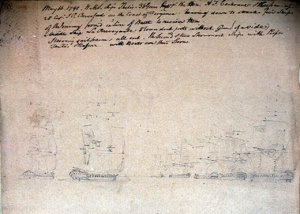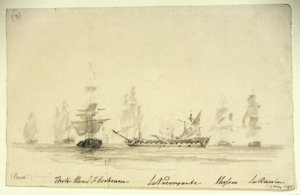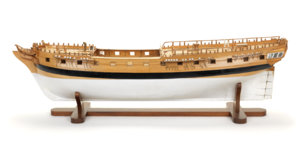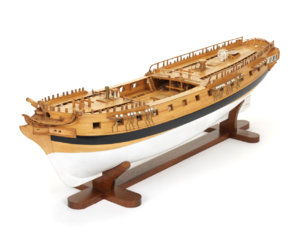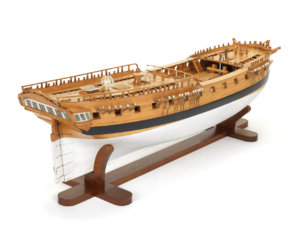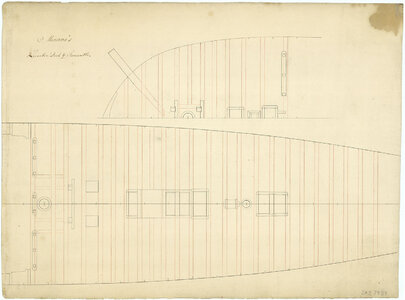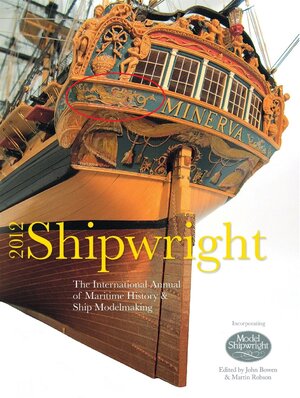HMS Phaeton was a 38-gun,
Minerva-class fifth rate of Britain's
Royal Navy. This
frigate was most noted for her intrusion into
Nagasaki harbour in 1808. John Smallshaw (Smallshaw & Company) built
Phaeton in Liverpool between 1780 and 1782. She participated in numerous engagements during the
French Revolutionary Wars and the
Napoleonic Wars during which service she captured many prizes.
Francis Beaufort, inventor of the
Beaufort Wind-Scale, was a lieutenant on
Phaeton when he distinguished himself during a successful
cutting out expedition.
Phaeton sailed to the
Pacific in 1805, and returned in 1812. She was finally sold on 26 March 1828.
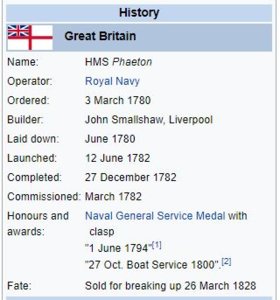
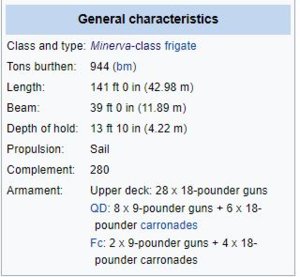
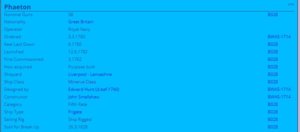
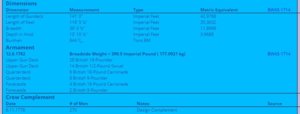 Early years
Phaeton
Early years
Phaeton was commissioned in March 1782. Within a year she had been paid off.
Service in the Channel

Sir Andrew Snape Douglas
In December 1792
Phaeton was commissioned under
Sir Andrew Snape Douglas.
[3] In March 1793
Phaeton captured the 4-gun privateer lugger
Aimable Liberté.
Then on 14 April
Phaeton sighted the French privateer
Général Dumourier (or
Général Du Mourier), of twenty-two 6-pounder guns and 196 men, and her Spanish prize, the
St Jago, 140 leagues to the west of
Cape Finisterre.
Phaeton was part of
Admiral John Gell's squadron and the entire squadron set off in pursuit, but it was
Phaeton that made the actual capture.
St Jago had been sailing from Lima to Spain when
General Dumourier captured her on 11 April. In trying to fend off
General Dumourier,
St Jago fought for five hours, losing 10 men killed and 37 wounded, before she
struck. She also suffered extensive damage to her upper works.
St Jago's cargo, which had taken two years to collect, was the richest ever trusted on board a single ship. Early estimates put the value of the cargo as some £1.2 and £1.3 million. The most valuable portion of the cargo was a large number of gold bars that had a thin covering of
pewter and that were listed on the manifest as "fine pewter".
General Dumourier had taken on board 680 cases, each containing 3000 dollars, plus several packages worth two to three thousand pounds.
The ships that conveyed
St Jago to
Portsmouth were
St George,
Egmont,
Edgar,
Ganges and
Phaeton. The money came over London Bridge in 21 wagons, escorted by a party of light dragoons, and lodged in the
Tower of London.
On 11 December the High Court of Admiralty decided that the ship should be restored to Spain, less one eighth of the value after expenses for salvage, provided the Spanish released British ships held at
Corunna. The agents for the captors appealed and on 4 February 1795 the Lords of the Council (the Privy council) put the value of the cargo at £935,000 and awarded it to the captors. At the time, all the crew, captains, officers and admirals could expect to share in the prize.
Admiral Hood's share was £50,000.
On 28 May
Phaeton took the 20-gun
Prompte off the Spanish Coast. The Royal Navy took
Prompte into service under her existing name.
Together with
Weazle,
Phaeton took two privateers in the Channel in June -
Poisson Volante, of ten guns, and
Général Washington. On 27 November
Phaeton and
Latona were among the six vessels of a squadron that captured the 28-gun
French corvette Blonde off
Ushant.
In February 1794
Phaeton was paid off, but the next month Captain
William Bentinck recommissioned her.
During the battle of the
Glorious First of June,
Phaeton came to the aid of the dismasted
Defence. While doing so,
Phaeton exchanged broadsides with the French ship-of-the-line
Impétueux.
Phaeton suffered three men killed and five wounded. She was the only one of the
support vessels there to suffer casualties. In 1847 the Admiralty awarded the survivors to that date of all the vessels at the battle, including
Phaeton, the Naval General Service Medal with clasp "1 June 1794".
Captain Robert Stopford

Portrait of Queen Caroline, ca. 1820, by James Lonsdale
In September,
Phaeton came under the command of Captain
Stopford. In May 1795
Phaeton escorted Princess
Caroline of Brunswick to England. Then began what would become a spectacular string of prize-taking. During Stopford's service in the
Channel,
Phaeton captured some 13 privateers and three vessels of war, and also recovered numerous vessels that the French had taken.

Admiral Sir Robert Stopford, c. 1840, by
Frederick Richard Say, from the
National Maritime Museum, Greenwich, London
On 10 March 1796,
Phaeton engaged and captured the French corvette
Bonne Citoyenne off
Cape Finisterre. She was armed with twenty 9-pounder guns and had a crew of 145 men. She had left Rochefort on 4 March in company with the French frigates
Forte,
Seine, and
Régénérée , and the brig
Mutine, all sailing for the
Île de France with troops and military supplies. Stopford took her back to England as his prize. The Royal Navy then bought her in as
Bonne Citoyenne, a
Sixth Rate sloop of war.
While cruising in the Channel, on 6 March 1797,
Phaeton took the French privateer
Actif. She was armed with 18 guns and had a crew of 120 men. She had sailed from Nantes on the 17 of February and ten days later had captured the
packet ship Princess Elizabeth, which was her only prize.
On 28 May,
Phaeton,
Melpomene, and the
hired armed lugger Speedwell detained
Frederickstadt.
On 16 September
Phaeton took the 6-gun
Chasseur. Then two days later she took the privateer
Brunette. Then with
Unite she took 16-gun
Indien on 24 September off the Roches Bonnes. On 9 October
Unite captured
Découverte, with the 32-gun frigate
Stag and
Phaeton in company.
Phaeton also recaptured three British vessels. These were
Adamant (24 September),
Arcade (3 October), and
Recovery (20 October).
Then on 28 December
Phaeton took the 12-gun
Hazard in the Bay of Biscay. The next day, the 44-gun
Anson, Captain
Philip Charles Durham, with
Phaeton, retook the 20-gun
Sphinx-class post ship Daphne, which the French had captured almost exactly three years earlier. Out of a crew of 276, including 30 passengers of various descriptions,
Daphne, lost five men killed and several wounded before she surrendered.
Anson had no casualties.
On New Year's Day, 1798,
Phaeton took
Aventure. On 19 February she took the 18-gun
Légère in the Channel. On 22 March she participated in damaging the 36-gun frigate
Charente near the
Cordouan lighthouse.
Phaeton fired on
Charente, chasing her first into range of the guns of the 74-gun
Third Rate Canada, under the command of Captain Sir
John Borlase Warren, with whom she exchanged broadsides.
Charente grounded, but then so did
Canada.
Phaeton and
Anson had to abandon the chase to pull
Canada free. In the meantime,
Charente threw her guns overboard, floated free, and reached the river of
Bordeaux, much the worse for wear.
With
Anson,
Phaeton took the 18-gun privateer
Mercure on 31 August.
Mercure was pierced for 20 guns and had a crew of 132 men. She was one day out of Bordeaux and had captured nothing.
A week later,
Anson and
Phaeton captured the 32-gun privateer
Flore after a 24-hour-long chase. Stopford, in his letter, described
Flore as a frigate of 36 guns and 255 men. She was eight days out of Boulogne on a cruise.
Flore had also served the Royal Navy in the
American Revolutionary War.
Then on 8 October
Phaeton took the 16-gun privateer
Lévrier. Together with HMS Ambuscade (1773) and
Stag, on 20 November she took
Hirondelle.
On 24 November 1798,
Phaeton captured the French privateer brig
Resolue (or
Resolu).
Resolue was armed with 18 guns and carried a crew of 70 men. She had previously captured the English merchant ship
General Wolfe, sailing from
Poole to
Newfoundland and an American sloop sailing from
Boston to
Hamburg.
Stag later recaptured the American.
On 6 December,
Phaeton and
Stag captured the French privateer brig
Resource. She was armed with 10 guns and carried a crew of 66 men. She had sailed from La Rochelle two days previously and was sailing for the African coast.
Ambuscade shared in the prize money for both
Resolu and
Resource.
Mediterranean
In July 1799 Captain Sir
James Nicoll Morris took command of
Phaeton and sailed with
Lord Elgin, of the eponymous
Elgin Marbles, for
Constantinople. Elgin would be Britain's ambassador to the
Ottoman Empire until 1803. In May 1800 she participated in the blockade of
Genoa as part of Lord
Keith's squadron. The Austrian general besieging the city, Baron d'Ott, particularly appreciated her fire in support of the Austrian army.
On 14 April 1800
Phaeton and
Peterel captured the
St. Rosalia.
Phaeton had to share her share of the proceeds with five vessels due to a prior agreement.
On 3 May,
Mutine,
Phaeton and
Cameleon captured eight vessels in Anguilla Bay:
- Stella de Nort;
- Santa Maria;
- Nostra Senora del Carmine;
- Fiat Volantes Deus;
- Nostra Signora del Assunta;
- Nostra Signora de Sonsove;
- San Nicolas; and
- San Joseph (San Giuseppe).
Five days later they captured eleven Genoese vessels. They captured the first eight at
St Remo:
- Polacre ship St. Giovanni, which was sailing in ballast from St Remo;
- Polacre brig Achille, which was sailing from Marseilles to Genoa with a cargo of corn and wine;
- Polacre barque St. Antonio, which was sailing from Cette to Genoa with a cargo of wine;
- Polacre brig Santa (Assunta), which was sailing from Ard to Port Maurice with a cargo of wine;
- Polacre ship Conception, sailing in ballast to Port Maurice;
- Polacre ship Madona del Carmine, sailing from Cette to Genoa with a cargo of wine;
- Settee Signora del Carmine, which was sailing from Marseilles to Genoa with a cargo of corn;
- Settee St. Giuseppe, which was sailing from Marseilles to Port Maurice with a cargo of corn;
- Settee Immaculate Conception, which was sailing from Cette to Genoa with a cargo of wine;
- Settee Amina Purgatorio, which sailing from Cette to Genoa with a cargo of wine; and
- Settee Virgine Rosaria, which was sailing from Cette to Genoa with a cargo of wine.

Francis Beaufort
On 25 October
Phaeton chased a Spanish
polacca to an anchorage under a battery of five heavy guns at
Fuengirola, where she joined a French privateer brig. The following night the brig escaped while the polacca tried twice, unsuccessfully, to escape to
Málaga. On the night of the 27 October, Francis Beaufort led
Phaeton's boats on a cutting out expedition. Unfortunately the launch, with a
carronade, was unable to keep up and was still out of range when a French privateer schooner, which had come into the anchorage unseen, fired on the other boats. The barge and two cutters immediately made straight for the polacca and succeeded in securing her by 5 am. The captured ship was the
San Josef, alias
Aglies, of two 24-pounder iron guns, two brass 18-pounder guns as stern chasers, four brass 12-pounder guns and six 6-pounder guns. She was a
packet, carrying provisions between Málaga and
Velilla. She had a crew of 49 seamen, though 15 were away, and there were also 22 soldiers on board to act as marines.
The boarding party suffered one man killed and three wounded, including Beaufort who received, but survived, 19 wounds.
[Note 5] The Spanish sustained at least 13 wounded.
Once Morris was sure that his men had secured the prize he sailed
Phaeton in pursuit of a second pollaca that had passed earlier, sailing from Ceuta to Málaga.
Phaeton was able to catch her under a battery at Cape Molleno. While
Phaeton was returning to pick up Beaufort, his men and their prize, the French privateer schooner sailed past, too far away for
Phaeton to intercept.
The British immediately commissioned
San Josef as a British
sloop-of-war under the name
Calpe, the ancient name for Gibraltar. Although it would have been usual to promote Beaufort, the successful and heroic leader of the expedition, to command
Calpe, Lord Keith chose instead
George Dundas who not only was not present at the battle, but was junior to Beaufort. In 1847 the Admiralty awarded the survivors to that date of the boarding party the Naval General Service Medal with clasp "27 Oct. Boat Service 1800".
On 16 May 1801, boats from
Phaeton and
Naiad under the direction of
Naiad's first lieutenant, entered the port of
Marín, Pontevedra, in Galicia in north west Spain. There they captured the Spanish corvette
Alcudia and destroyed the armed packet
Raposo, both under the protection of a battery of five 24-pounders.
Alcudia, commanded by Don Jean Antonio Barbuto, was moored stem and stern close to the fort. Her sails had previously been taken ashore so the boats had to tow her out but soon after a strong south-west wind set in and it was necessary to set her on fire. Only four men from the two British ships were wounded.
Phaeton then returned to Britain and was paid off in March 1802.
East Indies
In July 1803 Captain
George Cockburn recommissioned
Phaeton for service in the Far East. Later in 1804 she and
HMS Lancaster chased the French privateer
Henriette back to
Port Louis. Also,
Phaeton recaptured the
Mornington, which the French privateer
Nicholas Surcouf in
Caroline had captured on 14 August 1804; Captain Fallonard of the brig
Île de France recaptured
Mornington. The British recaptured
Mornington again as she continued to sail under the British Ensign until she was burnt in the Bay of Bengal in 1816.
On 2 August 1805, under Captain John Wood,
Phaeton fought the 40-gun
Sémillante, Captain
Léonard-Bernard Motard, in the
San Bernardino Strait off
San Jacinto, Philippines, together with the 18-gun
Cruizer class brig-sloop Harrier, Captain Edward Ratsey. After exchanges of fire first with
Harrier and then with
Phaeton,
Sémillante took refuge under the guns of a shore battery. Unable to dislodge her, the two British vessels eventually sailed off, each having suffered two men wounded.
Sémillante was reported to have suffered 13 killed and 36 wounded. After resupplying at San Jacinto,
Sémillante intended to sail for
Mexico in March 1805 to fetch
specie for the Philippines; the encounter with
Phaeton and
Harrier foiled the plan. Motard returned to the Indian Ocean, operating for the next three years against British shipping from
Île de France.
On 18 November 1805
Phaeton was at
Saint Helena. There she took on board 32 officers and crew from the East Indiaman
Brunswick, which the French had captured. The French had released them at the
Cape of Good Hope and a
cartel had delivered them to St Helena.
Phaeton was already carrying the
Marquis of Wellesley and his suite, who was returning to England after having served as Governor General of India. They arrived at Spithead on 13 January 1806.
In October 1806 Captain John Wood took command of
Phaeton. Then in July 1808, Captain
Fleetwood Pellew succeeded him.
Nagasaki Harbour Incident

Captain Fleetwood Pellew commanding
Terpsichore against Dutch vessels in
Batavia Road, 24 November 1806. Drawn at
Madras, May 1807
After the French had conquered the
Batavian Republic and Napoleon began to use its resources against
England, Royal Navy ships started to prey on Dutch shipping. In 1808,
Phaeton, by now under the command of Pellew, entered
Nagasaki's harbour to ambush a couple of Dutch trading ships that were expected to arrive shortly.
Phaeton entered the harbour on 4 October surreptitiously under a Dutch flag. Despite the arrival of this "Dutch" ship being later in the season than normal, the Japanese and Dutch representatives did not suspect anything. So, Dutch representatives from their Nagasaki trading enclave of
Dejima rowed out to welcome the visiting ship. But, as they approached,
Phaeton lowered a tender and captured the Dutch representatives, while their Japanese escorts jumped into the sea and fled. Pellew threatened to execute the Dutch representatives unless supplies (water, food, fuel) were delivered to
Phaeton.
Phaeton also fired cannons and muskets to press her demands, and Pellew threatened to destroy the Japanese and Chinese ships in the harbour. The cannons in the Japanese harbour defenses were old and most could not even fire. Consequently, the meager Japanese forces in Nagasaki were seriously out-gunned and unable to intervene.
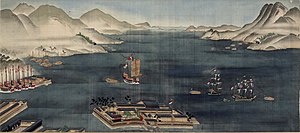
Dejima and Nagasaki Bay, circa 1820. The view includes two Dutch ships and numerous Chinese trading junks.
At the time, it was the
Saga clan's turn to uphold the policy of
Sakoku and to protect Nagasaki, but they had economized by stationing only 100 troops there, instead of the 1,000 officially required for the station. The
Nagasaki Magistrate,
Matsudaira Yasuhide (Nagasaki bugyō), immediately ordered troops from the neighbouring areas of
Kyūshū island. The Japanese mobilized a force of 8,000
samurai and 40 ships to confront the
Phaeton, but they could not arrive for a few days. In the meantime, the Nagasaki Magistrate decided to respond to the ship's demands, and provided supplies.
Phaeton left two days later on 7 October, before the arrival of Japanese reinforcements, and after Pellew had learned that the Dutch trading ships would not be coming that year. He left behind a letter for the Dutch director
Hendrik Doeff. The Nagasaki Magistrate, Matsudaira, took responsibility by performing
seppuku.
Following the attack of the
Phaeton, the
Bakufu reinforced coastal defenses, and promulgated a law prohibiting foreigners coming ashore, on pain of death (1825–1842,
Muninen-uchikowashi-rei). The Bakufu also requested that official interpreters learn English and Russian, departing from their prior focus on Dutch studies. In 1814, the Dutch interpreter
Motoki Shozaemon wrote the first English-Japanese dictionary (6,000 words). Although the incident revealed the vulnerability of the Tokugawa system to outside aggression, the Bakufu did not enter into more fundamental reform of its defenses because of its priority on maintaining the internal balance of power with the country's daimyo.
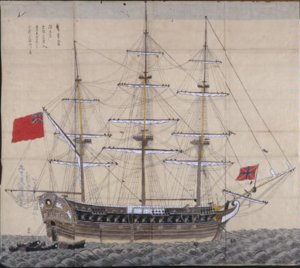
Contemporary Japanese drawing of HMS
Phaeton (Nagasaki Museum of History and Culture)
After Nagasaki
Pellew was confirmed in his rank of
post captain on 14 October 1808, and went on to see action in the
Invasion of Île de France in 1810 and the reduction of
Java in 1811.
In May,
Phaeton escorted the second division of British troops, commanded by Major-General
Frederick Augustus Wetherall, from
Madras to
Prince of Wales Island, and then on to
Malacca. Once the expedition reached
Batavia,
Phaeton and three of the other frigates patrolled for French frigates known to be in the area.
On 31 August a landing party from
Phaeton and
Sir Francis Drake, together with marines from
Hussar, captured a fort from the French at
Sumenep on the island of
Madura, off Java. The British lost three men killed and 28 wounded.
Pellew sailed
Phaeton home in August 1812, escorting a convoy of
East Indiamen. For his services he received a present of 500 guineas and the thanks of the
East India Company.
Post-war
In 1816, Capt. Frances Stanfell sailed
Phaeton from Sheerness, bound for
Saint Helena and the
Cape of Good Hope. She arrived at St Helena on 14 April 1816, where she delivered its newly-appointed military governor, Lieutenant-General Sir
Hudson Lowe, his wife, Susan de Lancey Lowe, and her two daughters by a former marriage. Lowe had been expressly sent to the island to serve as the gaolor of Napoleon Bonaparte, who would die there in exile in 1821.
In April 1818, Capt. W. H. Dillon commissioned
Phaeton. In the autumn of 1818 Lieutenant John Geary, who had joined
Phaeton at her re-commissioning, faced a court martial. The charges were that he had concealed two deserters from the band of the
18th Regiment of Foot. More formally, the charges were: "Inveigling musicians from one of the Regiments in garrison and with practicing deception towards the officers who were sent on board to search for them." The board found him guilty. He was severely reprimanded and dismissed from
Phaeton.
Robert Cavendish Spencer, late of
Ganymede, a captain on the board, thought enough of Geary to shake his hand and offer him a job in the future. Several years later Spencer made good on his offer.
Phaeton went on to the East Indies. In October 1819 she was paid off and then recommissioned within the month under Captain
William Augustus Montagu, for
Halifax. She was paid off in September 1822. She was immediately recommissioned under Captain Henry Evelyn Pitfield Sturt. She sailed for Gibraltar and Algeciras and was paid off some three years later.
Fate
Phaeton was sold on 11 July 1827 to a Mr. Freake for £3,430, but the Navy Office cancelled the sale, "Mr. Freake having been declared insane." She was finally sold on 26 March 1828 for £2,500 to Joshua Cristall for breaking up.
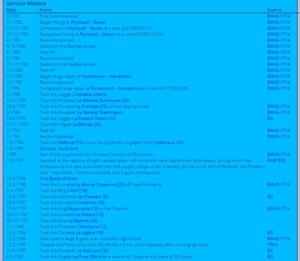
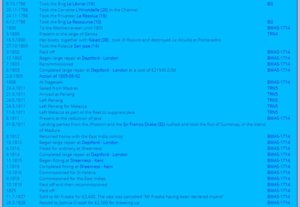
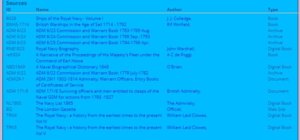

en.wikipedia.org
British Fifth Rate frigate 'Phaeton' (1782). Dates of service, name changes, previous and next incarnations, dimensions, armament, commanders, officers and crewmen, actions, battles, sources
threedecks.org
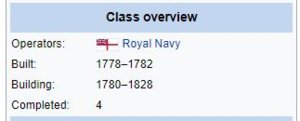
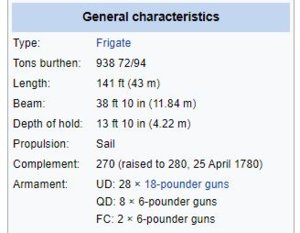
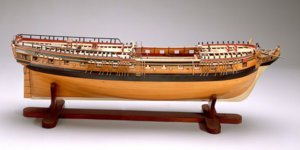
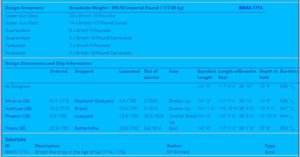
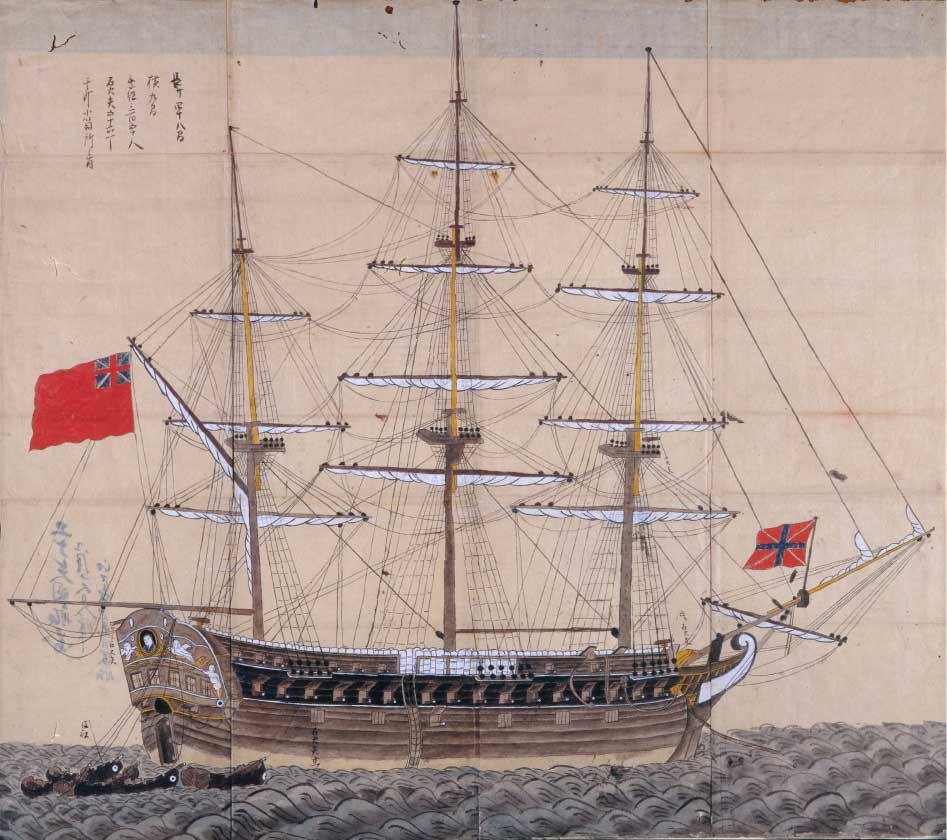
 en.wikipedia.org
en.wikipedia.org








